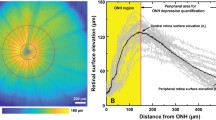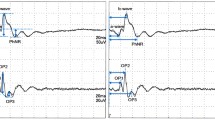Abstract
To determine whether long-term reduction of intraocular pressure leads to a corresponding preservation of the pattern electroretinogram (PERG), PERGs were studied in 21 patients with ocular hypertension who had received unilateral timolol therapy for a minimum of 6 years. The mean difference in intraocular pressure (IOP) between the placebotreated and the timolol-treated eyes (over 6 years) was 2.4mm Hg. Steady-state PERGs (16.0 rps) were obtained simultaneously in both eyes of each patient, with four check sizes (0.25, 0.5, 1.0 and 2.0 degrees). Significant (p < 0.05) steady-state PERG deficits (i.e., amplitude more than two standard deviations below the mean value of age-matched controls) were observed in 16 eyes of 12 patients (10 placebo-treated and 6 timolol-treated eyes). The mean PERG amplitude did not differ significantly between the placebo-treated and timololtreated eyes. However, a significant correlation (r = - 0.423) in the IOP differences between the placebo-treated and timolol-treated eyes and the corresponding PERG amplitude differences was noted in three of the four test conditions (i.e. 0.25, 0.5, and 1.0 degrees). These results suggest that reducing IOP may preserve ganglion cell function in some patients with ocular hypertension.
Similar content being viewed by others
Abbreviations
- IOP:
-
intraocular pressure
- PERG:
-
pattern electroretinogram
References
Riggs LA, Johnson EP, Schick AML. Electrical responses of the human eye to moving stimulus pattern. Science 1964; 144: 567–568.
Maffei L, Fiorentini A. Electroretinographic responses to alternating gratings before and after section to the optic nerve. Science 1981; 211: 953–955.
Harrison JM, O'Conner PS, Young SL, Kincaid M, Bentley R. The pattern ERG in man following surgical resection of the optic nerve. Invest Ophthalmol Vis Sci 1987; 28: 492–499.
Trick GL. Retinal potentials in patients with primary open angle glaucoma. Physiologic evidence for temporal tuning deficits. Invest Ophthalmol Vis Sci1985; 26: 1750–1758.
Holder GE. Significance of abnormal pattern electroretinography in anterior visual pathway dysfunction. Br J Ophthalmol1987; 71: 166–171.
Weinstein GW, Arden GB, Hitchings RA, Ryan S, Calthorpe CM, Odom JV. The pattern electroretinogram (PERG) in ocular hypertension. Arch Ophthalmol 1988; 106: 923–931.
Trick GL. PRRP abnormalities in glaucoma and ocular hypertension. Invest Ophthalmol Vis Sci 1986; 27: 1730–1736.
Marx MS, Podos SM, Bodis-Sollner I, Howard-Williams JR, Siegel MJ, Teitelbaum CS, Maclin EL. Severin C. Flash and pattern electroretinograms in normal and laser-induced glaucomatous primate eyes. Invest Ophthalmol Vis Sci 1986; 27: 378–386.
Berninger TA, Arden GB. The pattern electroretinogram. Eye 1988; 2(Suppl): 257–283.
Papst N, Bopp M, Schnaudigel OE. Pattern-ERG in patients with elevated intraocular pressure. Klin Monatoble Augenheilkd 1984; 185: 390–392.
Trick GL, Bickler-Bluth M, Cooper DG, Kolker A, Nesher R. Pattern reversal electroretinogram abnormalities in ocular hypertension: correlation with glaucoma risk factors. Curr Eye Res 1988; 7: 201–206.
Kass MA, Gordon MO, Hoff MAR, Parkinson JM, Kolker AE, Hart WM, Becker B. Topical timolol administration reduces the incidence of glaucomatous damage in ocular hypertensive individuals. A randomized, double-masked, long-term clinical study. Arch Ophthalmol 1989; 107: 1590–1598.
Epstein DL, Krug J, Hertzmark E, Remis L, Edelstein D. A long-term clinical trial of timolol therapy versus no treatment in the management of glaucoma suspects. Ophthalmology 1989: 96: 1460–1467.
Dawson WW, Trick GL, Litzkow C. An improved electrode for electroretinography. Invest Ophthalmol Vis Sci 1979; 18: 988–990.
Quigley, HM, Addicks EM, Green WR, Maumenee AE. Optic nerve damage in human glaucoma. II. The rate of injury and susceptibility to damage. Arch Opthalmol 1981; 99: 635–649.
Stamper R. Psychophysical changes in glaucoma. Surv Ophthalmol 1989; 33: 309–318.
Adams AJ. Ridoc R, Husted R, Stamper R. Spectral sensitivity and color discrimination changes in glaucoma and glaucoma-suspect patients. Invest Ophthalmol Vis Sci1982; 23: 516–524.
Sample PA, Weinreb RN, Boynton RM. Acquired dyschromatopsia in glaucoma. Surv Ophthalmol 1986; 31: 54–64.
Lakowski R, Bryett J, Drance SM. A study of color vision in ocular hypertensives. Can J Opthalmol 1972; 7: 86–95.
Trick GL, Nesher R, k Cooper DG, Kolker AE, Bickler-Bluth M. Dissociation of visual deficits in ocular hypertension. Invest Ophthalmol Vis Sci 1988; 29: 1486–1491.
Marx M, Podos SM, Bodis-Wollner I, Lee PY, Wang RF, Severin C. Signs of early damage in glaucomatous monkey eyes: Low spatial frequency losses in the pattern ERG and VEP. Exp Eye Res 1988; 46: 173–174.
Kwitko GM, Shin DH, Ann BH, Hong YJ. Bilateral effects of long term monocular timolol therapy. Am J Opthalmol 1987; 104: 591–594.
Porciatti V, Falsini B, Brunori S, Colotto A, Moretti G. Pattern electroretinogram as a function of spatial frequency in ocular hypertension and early glaucoma. Doc Ophthalmol1987; 65: 349–355.
Wanger P, Persson HE. Pattern reversal electroretinograms in unilateral glaucoma. Invest Ophthalmol Vis Sci 1983; 24: 749–753.
Author information
Authors and Affiliations
Additional information
This study was supported in part by a research fellowship awarded from the American Israeli Ophthalmology Society (RN), a research grant from the National Eye Institute EY-06046 (GLT), and a grant from Merck, Sharpe and Dohme Research Laboratories (MAK). Presented in part at the meeting of the Association for Research in Vision and Ophthalmology, 5 May 1988, Sarasota, Florida.
Rights and permissions
About this article
Cite this article
Nesher, R., Trick, G.L., Kass, M.A. et al. Steady-state pattern electroretinogram following long term unilateral administration of timolol to ocular hypertensive subjects. Doc Ophthalmol 75, 101–109 (1990). https://doi.org/10.1007/BF00146546
Accepted:
Issue Date:
DOI: https://doi.org/10.1007/BF00146546




